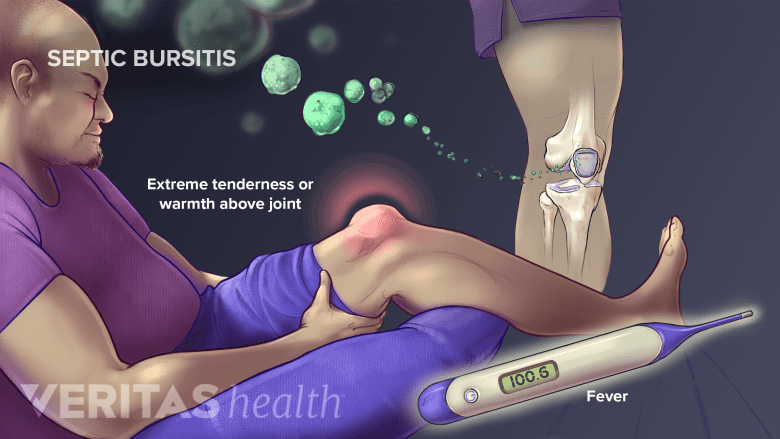It is possible for severe knee pain to be caused by an infection. How? Most often, bacteria or another type of microorganism infects the tissues in or around the knee joint. Other times, a separate infection, such as a stomach virus, leads to an auto-immune reaction that causes knee pain.
In This Article:
- Possible Causes of Severe Knee Pain
- How Infection Can Lead to Severe Knee Pain
- Causes of Knee Pain Video
Septic Knee Arthritis
Septic arthritis can cause moderate to severe knee pain, tenderness, swelling, stiffness, and warmth and redness of the skin over the knee. Some people with septic arthritis also get a mild fever or other flu-like symptoms. Symptoms may develop quickly, over hours or days.
Septic arthritis occurs when a microorganism, such as a bacteria or virus, invade a joint. The infecting organisms attack the delicate lining that surrounds the joint, called the synovial lining, and the joint fluid contained within it.
While septic arthritis can occur in children and young adults, more than half of people who develop it are over the age of 60.1Schmidt, S. Acute Infectious Arthritis. MSD Manual, Professional Version topic page, Table 1. Last updated January 2019. Accessed May 15, 2020. www.msdmanuals.com Septic arthritis is a potentially serious medical condition and prompt medical attention is advisable.
Reactive Arthritis
An achy, swollen, and/or red knee joint is a common symptom of reactive arthritis. Other joints can be affected, too. In addition to joint pain, symptoms can include red, irritated eyes; genital discharge; swollen fingers; and skin problems, such as rashes.
See Reactive Arthritis Symptoms
Reactive arthritis occurs when the body’s immune system has an abnormal response to an infection, such as a stomach bug or a sexually transmitted disease (STD). The infection may resolve days, weeks, or even months before the reactive arthritis symptoms appear.
See Infections that Can Cause Reactive Arthritis
Septic Knee Bursitis

Septic bursitis is a serious condition that requires immediate medical attention.
When septic bursitis occurs in the knee, a person may experience extreme warmth and redness of the skin at the knee joint, knee pain, fever and chills, and a general feeling of feeling of being unwell. An infected bursa will be swollen and feel squishy and tender to the touch.
See Septic Bursitis
Bursae are thin, lubricated, fluid-filled sacs that decrease friction between bone and the surrounding soft tissue, such as skin, muscles, ligaments and tendons. Bursitis is a condition marked by the inflammation of a bursa. When a bursa is not only inflamed but also infected, it is called septic bursitis.
Septic bursitis is a potentially serious medical condition and prompt medical attention is advisable. Most cases of knee bursitis are not septic. Aseptic knee bursitis is not accompanied by fever or other flu-like symptoms; however, the only sure way to distinguish between aseptic and septic is to test the bursa fluid.
Late-stage Lyme disease and other types of infection can cause joint pain, though these are less common.
Lab Testing for Infection
To rule out or diagnose an infection that causes knee pain, a doctor may want to perform an arthrocentesis, or joint aspiration.
See What Is Arthrocentesis (Joint Aspiration)?
Arthrocentesis involves using a needle and syringe to remove fluid from the inflamed knee joint or bursa. The fluid may be sent to a lab for testing. Arthrocentesis can also alleviate pressure and reduce knee joint pain.

